Abstract
The objective of this study was to build and develop anaerobic biodigesters for optimization of biogas production using food waste (FW) and sewage (S) co-digestion from a wastewater treatment plant (WWTP). The biodigesters operated with different mixtures and in mesophilic phase (37 °C). During the 60 days of experiments, all control and monitoring parameters of the biodigesters necessary for biogas production were tested and evaluated. The biodigester containing FW, S and anaerobic sludge presented the biggest reduction of organic matter, expressed with removal of 88.3% TVS (total volatile solid) and 84.7% COD (chemical oxygen demand) the biggest biogas production (63 L) and the highest methane percentage (95%). Specific methane production was 0.299 LCH4/gVS and removed. The use of biodigesters to produce biogas through anaerobic digestion may play an important role in local economies due to the opportunity to produce a renewable fuel from organic waste and also as an alternative to waste treatment. Finally, the embedded control and automation system was simple, effective, and robust, and the supervisory software was efficient in all aspects defined at its conception.
1. Introduction
Nowadays, one of the biggest problems faced by many countries, particularly developing ones, is the final disposal of municipal solid waste (MSW), mainly due to environmental, social, and economic problems caused by its poor management. Costs related to collection, transport and treatment still make it difficult for adequate waste management, as its disposal is made in inappropriate areas, such as dumps, ditches, and other places devoid of adequate infra-structure [,]. Besides the problems associated with MSW, pollution of water resources and access to energy sources have historically represented challenges for economic growth, human health, and environmental preservation all over the world [,].
In Brazil, MSW presents organic matter as its biggest share, coming mainly from restaurants and households []. Anaerobic digestion is one of the solutions to reduce these problems and also an attempt to reuse MSW. It is known that anaerobic digestion is a process through which organic waste is biologically converted using a microbial consortium in the absence of oxygen []. In addition to stabilizing the organic load of waste, it generates products such as biogas, rich in methane, and digestate, which can be used as soil conditioner and is historically utilized for stabilizing sludge originated from sewage treatment, although it is a feasible application for any organic matter treatment []. Besides the potential for renewable energy generation, anaerobic digestion has become increasingly studied and more popular due to many factors, such as reduction of waste disposal in sanitary landfills and provision of energy to small communities situated away from urban centers. Another considerably evident advantage is the smaller generation of sludge. In anaerobic digestion about 10% of organic waste is turned into sludge, and the remaining 90% is used as biogas. Also important to highlight is the application of anaerobic processes at both small and large scale, with low implementation costs, low demand of area and good tolerance for high organic loads []. Therefore, biogas production and development of technologies for biomethane generation have been encouraged by many countries as an alternative for electricity generation or cogeneration of internal power engines [,,,].
Initially, mesophilic anaerobic co-digestion of a mixture consisting of a college restaurant food waste and sewage from a treatment plant were evaluated, in different proportions, with a view to obtaining a better use of organic waste and bigger methane production. The use of anaerobic digestion for treatment of the organic share of municipal solid waste, as well as food and street market waste, is largely mentioned in literature [,,,]. Consequently, anaerobic digestion has revealed itself as a promising treatment for urban solid waste produced in Brazil. Besides biogas, anaerobic digestion produces a digestate rich in nutrients which, depending on their characteristics, can be used as fertilizer or soil corrective. Environmentally speaking, its application on soil represents a more attractive option, as it allows nutrients to be recovered and reduces loss of organic matter suffered by soils under agricultural exploitation [].
However, for power generation viability, it is necessary the use of anaerobic biodigesters, built at low cost and with high technology, along with control of all parameters for biogas production optimization. In this sense, the main objective of this study was to develop anaerobic biodigesters with control and automation systems, and for that purpose this project was divided into the following phases: bioreactor development (anaerobic biodigesters), heating system construction, agitation system, gases monitoring system, using initially, methane sensors (CH4), carbon dioxide (CO2), and hydrogen sulfide (H2S), and finally software development to monitor and control the most important parameters during the process. The main bases were use of low cost materials, current monitoring technologies and simple control and methods to use the system with a view to large-scale reproduction in future.
2. Materials and Methods
2.1. Sample Collection and Description: Food Waste, Sewage and Anaerobic Sludge (Inoculum)
Raw sewage was collected from a wastewater treatment plant located in the city of Rio de Janeiro after removing sand from the preliminary treatment. Description was made according to Chemical Oxygen Demand (COD), moisture, pH, Total Solids (Volatile and Fixed), Total Kjedahl Nitrogen (TKN) and Total Phosphorus (TP). The anaerobic sludge used as inoculum in the experiments was collected from Upflow Anaerobic Sludge Blanket (UASB) reactor in operation at a local industry, making the same descriptions of raw sewage. After withdrawing an aliquot for characterization, sludge was stored under refrigeration (4 °C) until time of use. All analyses were determined according to Standard Methods for the Examination of Water and Wastewater []. For food waste, the same characterization as the one used for raw sewage and sludge was made, as well as total carbon test (CT). Collection of food waste was executed after meal time, when the rest removed from plates and utensils was submitted to screening, for separation from organic fraction, and homogenized through quartering, according to Brazilian norm []. Next, the homogenized material was ground with distilled water in the appropriate proportions, and part of the ground material (called food waste) was stored under refrigeration (4 °C) until time of use, and part preserved in a freezer (−20 °C).
Initially many experiments were carried out at small scale, using 100 mL penicillin bottles to find the ideal proportions for ultimate biogas production. In experiments with penicillin bottles the ground food waste was mixed with raw sewage to obtain different proportions of Dry Weight (DW): 20% 15%, 10% e 5%, with a view to evaluating moisture effect. Experiments were conducted with and without anaerobic sludge addition (inoculum) at the proportion of 10% v/v, for evaluation of seeding effect. The selected moisture was also used as basis for waste mixture in benchtop digesters experiments. Mixtures had their pH corrected to values between 7 and 8 using 1 M sodium bicarbonate solution (NaHCO3), and were supplemented with potassium phosphate monobasic to correct phosphorus concentration, according to a relation COD:P of 350:1. The bottles were closed with rubber bungs and aluminum seals, and incubated at 37 ± 2 °C until stabilization of biogas production was reached, for 30 days, and the volume was measured through displacement of 60 mL plastic syringe plunger connected to rubber seals. Final volume used was 75% of total bottle volume, thus providing a 25% safety margin from middle surface to mouth bottle. This margin was important for, during the process, biogas blisters disturb the medium and transport it upwards, which can block the syringes. Every time stabilization of biogas volume in the syringes was reached, the biogas produced and conditioned in syringes was stored at −5 °C until analysis was made using gas chromatography. In this initial optimization phase of experiments, analyses of COD, Total Solids (Volatile and Fixed) and pH were carried out before and after anaerobic digestion process. Anaerobic sludge used as inoculum was collected in anaerobic reactor from poultry slaughter industry, being characterized in terms of volatile total solids. Each condition was evaluated with triplicates, and average values of biogas production were considered. Following this experimental phase, the ideal fraction was used in anaerobic biodigesters, at benchtop scale, built and developed in laboratory with total volume of 7 L. The experiments carried out followed the phases described in flow chart of Figure 1.

Figure 1.
Flow chart of experimental phases carried out in this study.
2.2. Ideal Dry Weight Determination (DW) for Use in Biodigesters
The choice of ideal DW quantity to be put in biodigesters at benchtop scale was made from three experiments, in penicillin bottles, described as follows: Experiment 1 with different mixtures of food waste, with and without seeding. Mixtures were made to obtain 20%, 15% and 10% in DW; in Experiment 2 triplicates with different mixtures of sewage and food waste were made, with and without seeding. The objective was to obtain 20%, 15%, 10% and 5% in DW; and Experiment 3 used triplicates of different mixtures of 10% and 5% DW of sewage and food waste with anaerobic sludge (inoculum), and pH adjustment at the beginning of the experiment. All experiments were performed at 37 ± 2 °C and atmospheric pressure, for 30 days.
2.3. Development and Construction of Anaerobic Biodigesters for Biogas Production
After optimization of proportions made in penicillin bottles, experiments in bioreactors (anaerobic biodigesters) were initialized. Following the tendency to use simple materials, firstly the bioreactor was conceived and a glass container with cylindrical geometry was manufactured, involved with acrylic with total volume of 7 L, hermetically closed with a polyurethane cap. Seven holes were done on this cap, with a central hole for the stirring rod passage and the others for: biogas exit, temperature sensors accommodation, CH4, CO2, H2S, pH, entrance and withdrawal of material, and the remaining closed and reserved for future application. The heating system was based on a thermostatic bath, consisting of one recipient manufactured in acrylic and dimensioned so that it could accommodate the bioreactor and the bath liquid, an electrical resistance vulgarly known as “body heater”, and a water pump, used in car windshield wiper nozzle, for the circulation of the bath fluid. Agitation system was developed using an engine, commonly used for spinning microwave plates. This kind of engine was chosen as it has a low cost and functions in low rotation, which is preferable when it comes to anaerobic biodigesters. A stirring rod specially developed for these biodigesters was attached to the engine. The assembly scheme and addition of materials used in the experiments are shown in Figure 2; after that pH was adjusted before sealing to block oxygen entrance.
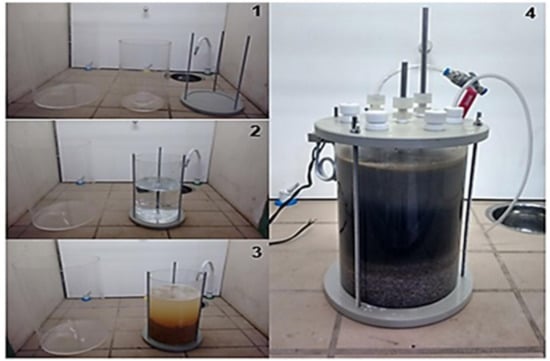
Figure 2.
Biodigesters assembly phases for experiments execution. (1) The glass bioreactor and the support; (2) The bioreactor coupled to the support; (3) The bioreactor with solid waste; and (4) The bioreactor after addition of the inoculum and closed.
2.3.1. Software Development for Control and Monitoring
The developed control and automation unit consisted of a system furnished with control and Programmable Logic Controller (PLC), which communicates with a supervisory software. This system was completely developed: supervisory hardware, firmware and software []. The projected hardware can be divided into following main parts: microcontroller for the Central Processing Unit (CPU), communication between microcomputer-microcontroller, power modules and sensors signal conditioning modules aimed at providing for the system’s needs, digital-analog converters (DAC) for the sensors, high power actuators, agitation engine and system for communication with the microcomputer. The control and automation software was developed through Microsoft Visual Studio 2012 using programming oriented to objects and Visual Basic language, having as requirements, defined at its conception, pH online monitoring, temperature, water pump activation control, agitation engine, PID temperature control, collected data storage, and analysis and visualization of parameters monitored by remote access. The complete biodigester functioning scheme is shown in Figure 3.
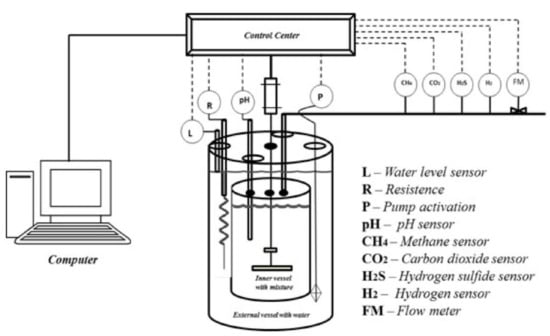
Figure 3.
Complete representation of anaerobic biodigester functioning, developed and used on this study experiments.
2.3.2. Analysis and Calibration of Sensors in Biogas Produced Compounds
Initially biogas produced in biodigesters was stored in Sigma Aldrich Tedlar bags (St. Louis, MO, USA), specially prepared for gases. Biogas characterization was made in a gas chromatograph (Agilent Technologies, model 7820A, Santa Clara, CA, USA), with thermal conductivity detectors (TCD) and flame ionization detectors (FID). Samples were analyzed in triplicates, and to calculate concentrations, patterns of CO2, CH4, H2S (White Martins) were used. The gas sensors used were models MQ, Hanwei Electronics Co., Ltd., (Zhengzhou, China), which were pattern-calibrated. Results were compared with chromatographic analyses to verify detection efficiency and quantification of online monitoring system made by the sensors installed and the software developed.
3. Results and Discussion
3.1. Description of Food Waste Used before Blending
During this optimization phase, with a view to verifying the best proportions to be used in the biodigesters, three collections of secondary sludge, food waste and sewage were carried out, and only one test of Total Carbon (CT) was performed for food waste of 68.6 mg/L; the remaining descriptions are presented on Table 1.

Table 1.
Description of residues used in mixtures.
Food waste presented moisture lower than sludge and sewage, but after being blended it presented moisture close to values obtained for sewage and sludge. Residues presented acid pH, below 7, showing that its final mixture will have acid pH, and that the addition of an alkalizer to adjust pH at the beginning of the experiments will be necessary. Initially pH adjustment was done with NaHCO3, which could hinder anaerobic digestion as it would increase sodium concentration at inhibiting levels. Food waste low C/N ratio (3.8) indicated presence of high nitrogen concentrations on residue which, in this case, can be converted into ammonia, promoting pH increase and inhibiting methanogenic microorganisms []. High TVS value in food waste suggests the possibility of biogas production increase, specially methane, when blended with sewage sludge. Work by Kim et al. [] evaluated the blend of food waste with sewage sludge and noted that the addition of organic waste improves anaerobic digestion. Based on the results obtained in the initial phase, the best proportion was 10% in dry weight (DW).
3.2. Biodigesters Construction and Efficiency of Food Waste and Sewage Co-Digestion
In this second phase of the study, after optimization of ideal proportion, three biodigesters were built in the following situations: Biodigester B1 containing only a mixture of food waste and Sewage; Biodigester B2 containing a mixture of Food Waste, Sewage and Anaerobic Sludge (inoculum); and Biodigester 3 with a blend of Food Waste, Water and Anaerobic Sludge. Biodigester B1 was used as a standard experiment, that is, an experiment with the objective of verifying co-digestion viability without the presence of inoculum. For the mixtures, tests of Chemical Oxygen Demand (COD), Total Solids (TS) and Total Volatile Solids (TVS) were performed at the beginning and monitored during the 60 days of the experiment, besides pH, yield, biogas production and all biodigesters operability parameters. A complete scheme of the biodigesters in operation during the experiments is shown in Figure 4.
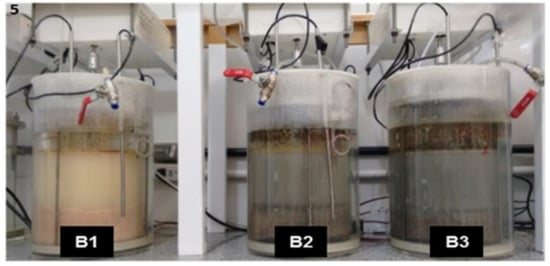
Figure 4.
Operational and efficiency experiments on biodigesters constructed using different mixtures and proportions. B1: Food residue + Sewage; B2: Food residue + Sewage + Sludge (inoculum); and B3: Food residue + Water + Sludge (inoculum).
Efficiency profiles of anaerobic co-digestion bioprocess of food waste and sewage for Biodigesters B2 and B3 are presented in Figure 5 and, as it can be noted, TS, TVS and COD concentrations were similar at the beginning. For Biodigester B3, a low removal of TVS occurred, compared with B2, but with stable removal since the beginning of the experiment, obtaining removal of total solids and total volatile solids of 53.8% TS, 75.1% TVS and 46.2 COD at the end of the 60 days of experiment. Biodigester B2 showed high elimination of organic waste, expressed with the removal of 88.3% TSV and 84.7% COD. These results can be associated with different types of residues present in biodigesters, specially co-digestion of sewage with food waste, which probably contributed for the increase of organic matter degradation and the higher biogas production such as presented on Table 2. These results showed that the specific methane production was 0.299 LCH4/gVS removed to Biodigester B2, and 0.116 LCH4/gVS for Biodigester B3.
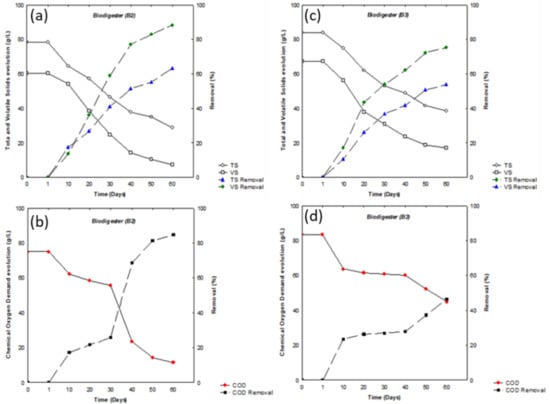
Figure 5.
Efficiency profiles of anaerobic co-digestion bioprocess of food waste and sewage for Biodigesters B2 and B3 during the 60 days of experiments. (a) removal of TS and VS from B2; (b) removal COD from B2; (c) removal of TS and VS from B3; and (d) removal COD from B3.

Table 2.
Production of removed organic waste and methane yield in Biodigesters B2 and B3 after 60 days of experiments.
To evaluate detection level and quantification of gases sensors (CH4, CO2 and H2S), a system which could condition biogas in a closed system was used. Every two days this sample passed through the sensors and the result was then compared with the ones from chromatographic analyses. In all samples errors below 5% were found, implying a high reliability on the monitoring system developed in the biodigesters. Efficiency profile of methane production associated with pH variation in Biogas is shown in Figure 6. Although the results of biogas total volume production were different for Biodigesters B2 and B3, gases behavior (CH4, CO2 and H2S) produced by biodigesters, in percentage, had similar values, that is, initially a high CO2 production (acetogenesis phase) occurred, and as time went by concentration was decreasing and concentration of methane with basic pH was increasing. H2S behavior was similar for both biodigesters. A pH correction during the first 10 days in Biodigester B2 became necessary, the same occurring in Biodigester B3 in the first 20 days. In Biodigester B2 necessary pH control was performed with addition of sodium hydroxide (6N).
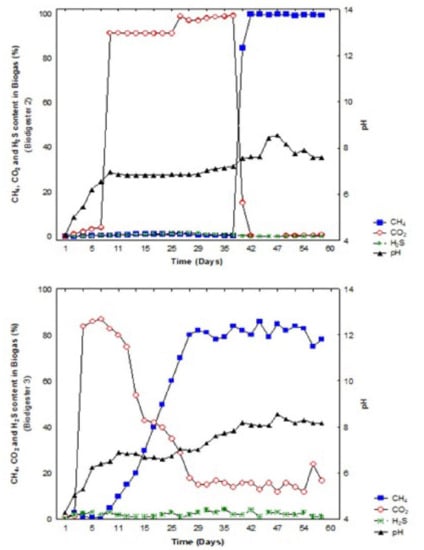
Figure 6.
Efficiency profile of methane production associated with pH variation in Biogas. The Biodigester 2 presented higher methane production from the thirty-seventh day of experiment and the Biodigester 3 started the production of methane in a shorter period of time (from the tenth day of experiment).
4. Conclusions
It was possible to evaluate the influence of food waste and sewage co-digestion in biogas production for anaerobic digestion processes. A mixture of Biodigester B2 presented the highest biogas production (63 L), the biggest methane return (95%) and the best TS, TVS and COD reductions on the 60 days of experiments. The better efficiency of Biodigester B2, compared to B3, cannot be attributed only to sewage addition to the mixture, since the concentration of organic matter in sewage is usually low. Such result might be associated with composition of substances present in sewage which complement anaerobic microorganisms needs and contributed to better conditions during biodegradation of food waste components. Another important factor is that probably food waste does not contain representatives of all microbial population necessary for its complete degradation; consequently, it might have influenced biogas production in Biodigester B3, making it slower and lower. Regarding the developed biodigesters, the bioreactor physical system proved adequate and allowed us a clear visualization of the fermenting medium, as well as checking whether the agitation system was effective or not. Besides, it guaranteed a low H2S production in biogas, due to a complete system sealing, preventing oxygen entrance in the medium. Finally, with these and other results we can conclude that the biodigester developed with the automation and control system was satisfactory for biogas production. The control parameters of pH, temperature, agitation, and the software developed for biogas monitoring worked well. The use of current technologies and low-cost materials was enough for the experimental purpose and can be used at larger scale in future.
Acknowledgments
The authors would like to acknowledge financial support from CNPq (Brazil).
Author Contributions
Claudinei de Souza Guimarães conceived and designed the experiments, corrected and revised the manuscript; Eduardo Gonçalves Serra made a great contribution to the revision of the manuscript, analysis and interpretation of the experimental results; David Rodrigues da Silva Maia carried out the assembly and calibration of the experiments, developed the automation and control system for biodigesters. All authors read, corrected, and approved the manuscript.
Conflicts of Interest
The authors declare no conflict of interest.
Abbreviations
| CPU | central processing unit |
| DAC | digital-analog converters |
| FID | flame ionization detectors |
| FW | food waste |
| MSW | municipal solid waste |
| PID | proportional–integral–derivative |
| PLC | programmable logic controller |
| S | sewage |
| TCD | thermal conductivity detectors |
| WWTP | wastewater treatment plant |
References
- Carlini, M.; Mosconi, E.M.; Castelluci, S.; Villarini, M.; Colantoni, A. An Economical Evaluation of Anaerobic Digestion Plants Fed with Organic Agro-Industrial Waste. Energies 2017, 10, 1165. [Google Scholar] [CrossRef]
- Apetato, M.M.; Nobre, A.M.; Alves, J.C.; Robalo, G.S.; Ferreira, F. Taxa de Resíduos Urbanos: Deficiências e Soluções. In Proceedings of the 6a Conferência Nacional sobre Qualidade do Ambiente, Lisboa, Portugal, 20 October 1999; Editora Plátano: Lisboa, Portugal, 1999; Volume 3, pp. 363–369. [Google Scholar]
- Lindkvist, E.; Johansson, M.T.; Rosenqvist, J. Methodology for Analysing Energy Demand in Biogas Production Plants—A Comparative Study of Two Biogas Plants. Energies 2017, 10, 1822. [Google Scholar] [CrossRef]
- Lansing, S.; Botero, R.B.; Martin, J.F. Waste treatment and biogas quality in small-scale agricultural digesters. Bioresour. Technol. 2008, 99, 5881–5890. [Google Scholar] [CrossRef] [PubMed]
- Plano Nacional de Resíduos Sólidos. Lei n° 12.305/10. Available online: http://www.mma.gov.br/estruturas/253/_publicacao/253_publicacao02022012041757.pdf (accessed on 30 March 2017).
- Li, Y.; Park, S.Y.; Zhu, J. Solid-state anaerobic digestion for methane production from organic waste. Renew. Sustain. Energy Rev. 2011, 15, 821–826. [Google Scholar] [CrossRef]
- Cecchi, F.; Pavan, P.; Alvarez, J.M.; Bassetti, A.; Cozzolino, C. Anaerobic digestion of municipal solid waste: Thermophilic vs. mesophilic performance at high solids. Waste Manag. Res. 1991, 9, 305–315. [Google Scholar] [CrossRef]
- Chernicaro, C.A.L. Princípios do Tratamento Biológico de águas Residuárias. Reatores Anaeróbios; Universidade Federal de Minas Gerais: Belo Horizonte, Brazil, 1997. [Google Scholar]
- Budzianowski, W.M.; Budzianowska, D.A. Economic analysis of biomethane and bioelectricity generation from biogas using different support schemes and plant configurations. Energy 2015, 88, 658–666. [Google Scholar] [CrossRef]
- Patterson, T.; Esteves, S.; Dinsdale, R.; Guwy, A. Life cycle assessment of biogas infrastructure options on a regional scale. Bioresour. Technol. 2011, 102, 7313–7323. [Google Scholar] [CrossRef] [PubMed]
- Jha, A.K.; Li, J.; Zhang, L.; Ban, Q.; Jin, Y. Comparison between Wet and Dry Anaerobic Digestions of Cow Dung under Mesophilic and Thermophilic Conditions. Adv. Water Resour. Prot. 2013, 1, 28–38. [Google Scholar]
- Venkatesh, G.; Elmi, R.A. Economic-environmental analysis of handling biogas from sewage sludge digesters in WWTPs (wastewater treatment plants) for energy recovery: Case study of Bekkelaget WWTP in Oslo (Norway). Energy 2013, 58, 220–235. [Google Scholar] [CrossRef]
- Ward, A.J.; Hobbis, P.J.; Holliman, P.J.; Jones, D.L. Optimization of the Anaerobic Digestion of Agricultural Resources. Bioresour. Technol. 2008, 99, 7928–7940. [Google Scholar] [CrossRef]
- Fernandez, J.; Perez, M.; Romero, L.I. Kinetics of mesophilic anaerobic digestion of the organic fraction of the municipal solid waste: Influence of initial total solid concentration. Bioresour. Technol. 2010, 101, 6322–6328. [Google Scholar] [CrossRef] [PubMed]
- Kim, D.H.; OH, S.E. Continuous high-solids anaerobic co-digestion of organic solid wastes under mesophilic conditions. Waste Manag. 2011, 31, 1943–1948. [Google Scholar] [CrossRef] [PubMed]
- Charles, W.; Walker, L.; Cord-Ruwisch, R. Effect of pre-aeration and inoculum on the start-up of batch termophilic anaerobic digestion of municipal solid waste. Bioresour. Technol. 2009, 100, 2329–2335. [Google Scholar] [CrossRef] [PubMed]
- Mata-Alvarez, J.; Macé, S.; Llabrés, P. Anaerobic Digestion of Organic Solid Wastes. An Overview of Research Achievements and Perspectives. Bioresour. Technol. 2000, 74, 3–16. [Google Scholar] [CrossRef]
- American Public Health Association (APHA). Standard Methods for the Examination of Water and Wastewater, 21st ed.; American Public Health Association: Washington, DC, USA, 2005. [Google Scholar]
- Brazilian Association of Technical Standards. NBR 10007. Sampling of Solid Waste, 2nd ed.; Brazilian Association of Technical Standards: Rio de Janeiro, Brazil, 2004. [Google Scholar]
- Guimarães, C.S.; Maia, D.R.S.; Serra, E.G. Control and Monitoring Software Website. GitHub. 2018. Available online: https://github.com/DavidRSMaia/Software-de-Controle-e-Monitoramento (accessed on 22 February 2018).
- Appels, L.; Baeyens, J.; Degrève, J.; Dewil, R. Principles and potential of the anaerobic digestion of waste-activated sludge. Prog. Energy Combust. Sci. 2008, 34, 755–781. [Google Scholar] [CrossRef]
- Kim, H.-W.; Han, S.-K.; Shin, H.-S. The optimisation of food waste addition as a co-substrate in anaerobic digestion of sewage sludge. Waste Manag. Res. 2003, 21, 515–526. [Google Scholar] [CrossRef] [PubMed]
© 2018 by the authors. Licensee MDPI, Basel, Switzerland. This article is an open access article distributed under the terms and conditions of the Creative Commons Attribution (CC BY) license (http://creativecommons.org/licenses/by/4.0/).